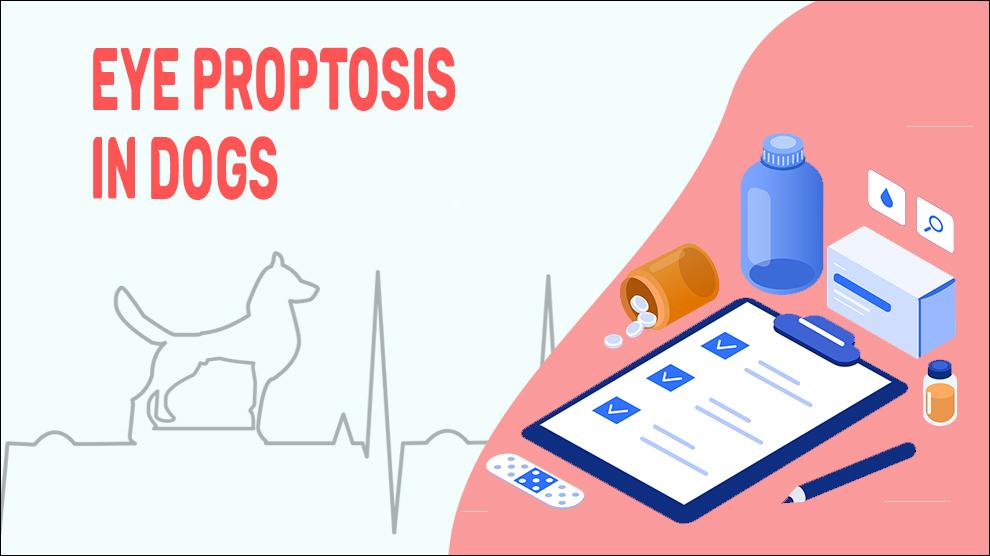Proptosis describes an anterior displacement or protrusion of any organ. Eye proptosis also called ocular proptosis, is referred to the as passive or mechanical protrusion of the eye (the globe) from its socket (orbit) while Exophthalmos refers specifically to active protrusion of one eyeball or both from the eye socket.
The “bug-eyed” dogs such as brachycephalic breeds having prominent protruding eyes with short muzzles should be checked often. These dogs are more prone to eye proptosis. Identification of eye proptosis can be easily done by front viewing of the head, the relative prominence of the globe, the size of the palpebral fissure, and comparing the angle of the eyelashes.
Eye proptosis is also specifically referred to as eye protrusion caused due to Graves disease. One in three dogs with proptosis in one eye (unilateral) has markedly high thyroid hormone levels. About 90% of bilateral proptosis is associated with hormonal abnormalities.
Eye proptosis is an ocular emergency that requires immediate attention. This may be accompanied by third eyelid prolapse, deviation of the globe, conjunctival swelling/ chemosis/ oedema, a widened palpebral fissure, a decreased ability to blink, exposure to keratitis, and epiphora.
Symptoms Of Eye Proptosis
- Prominent eye/ Eye is protruding out of the orbit
- Periocular pain
- Reduced eye movements
- Bruising/ Swelling of the eyelid
- Discharge from the eye
- Ophthalmoplegia
- Hyperemic conjunctiva
- Ulceration of the cornea
- Unable to close the eyelid over the eye
- Protrusion of the third eyelid
- Severed/torn muscles and or eye ligaments
- Dry eye/ Crossed eyes
- Constricted pupils
- Visual impairment
Treatment Options For Eye Proptosis
Treatment can be divided into two modalities- medical and surgical.
Medical treatment:
- Supportive therapy
- Oral and/or Systemic Antibiotics
- Lubricant ointments and/or antibiotic ointments
- Eyelid Sutures to protect the eye and prevent further protrusions
- Sometimes, immunosuppressive therapy (medications that suppress the immune system) with corticosteroids may be necessary
Surgical:
Globe replacement: When the dog has optic nerve damage or three extraocular torn muscles or if the eyeball is ruptured or a detached retina, globe replacement will not be attempted.
Temporary tarsorrhaphy: To protect the cornea, the globe is re-attached and the eyelids of the eye are partially sutured for a time period.
Home Remedies For Eye Proptosis
- Gently washing the face using baby shampoo and/or applying warm compresses to the eyes can help discharge the oil in the tear glands.
- The preliminary healing period in dogs after surgery for complications related to proptosis is approximately 2 weeks. All through that period, make your dog wear a cone or other protection and have their movement limited to leash walks only.
- After surgery, most pets will take a little time to adapt to the new vision, if there is any vision impairment due to proptosis.
Prevention Of Eye Proptosis
Prevention is not possible for proptosis as the causes in dogs are varied.
Eye proptosis due to the hereditary abnormality can be prevented by stopping the breeding of affected dogs so that the risk of passing the condition on to the next generation is averted.
Affected Breeds Of Eye Proptosis
Shih Tzu, Flat Faced Breeds, Pekingese, Pug, Boston Terrier, Chihuahua, Lhasa Apso, French Bulldog, Short Nose Dog Breeds
Additional Facts For Eye Proptosis
1. Causes:
Trauma:
- Paralysis
- Birth trauma
- temporal bone fracture, Fractures to the skull base
- Facial injuries
Infection:
- Viral and bacterial infections
- Mastoiditis
- Fungal (Mucormycosis)
- Immunocompromised dogs
Metabolic:
- Hyperthyroidism
- Diabetes mellitus
- Hypertension
Tumour:
- Leukemia
- Carcinoma (primary or metastatic)
- Facial nerve tumor
- Cholesteatoma
- Meningioma
- Haemangioblastoma
- Acoustic neuroma
- Sarcoma
Toxic:
- Arsenic
- Thalidomide
- Alcohol excess
- Carbon monoxide
2. Types:
Eye proptosis types are based on the causes:
- Foreign bodies in the orbit: e.g., due to injury.
- New growth invasion of the orbit: e.g., benign or malignant space-occupying orbital tumors such as neuroblastoma, capillary haemangioma, neurofibromatosis, lymphoma, leukemia, pseudotumors, secondary deposits ( metastatic), and mucocele.
- Obstruction with the venous returning from the orbit, e.g., cavernous sinus thrombosis, carotid-cavernous fistula, orbital varices, etc.
- Encroachment of inflammation into the orbit: e.g., orbital cellulitis, thyroid-related eye disease, IgG4-related disease, granulomatosis with polyangiitis, and sarcoidosis.
3. Mortality: There is no mortality due to this condition documented yet.
4. Diagnosis:
- Complete blood count and a serum chemistry panel
- Skull x-rays
- Orbital ultrasound
- Biopsy of the eye orbit
- CT SCAN/MRI
5. Prognosis:
Eye proptosis isn't a life-threatening condition, but it can ultimately lead to eye problems. Discuss with your vet to figure out the underlying cause.
When the Eye proptosis causing factor is identified, it can be treated with either medication to keep the eyes moisturized or surgery is recommended.
When To See A Vet
Contact your vet right away, if you notice any of the following:
- Eye is bulging out of the orbit
- Bruising/ Swelling of the eyelid
- Discharge from the eye
Food Suggestions For Eye Proptosis
- Omega-3 oily fishes such as salmon, tuna, cod, etc.
- Pick seafood over the usual beef and chicken.
- Nonmeat/plant protein sources such as nuts, Lentils, Beans, Eggs, etc.
- Leafy greens such as spinach, kale, watercress, etc.
- Citrus fruits or juices.
- Sweet potatoes,tomatoes, pumpkin.
- Blueberries, Broccoli, cabbage, carrots.
- Pork, tuna, Oysters.
Conclusion
Hereditary abnormality (brachycephalic breeds) caused by proptosis can be surgically corrected, and the prognosis is excellent. Proper treatment of Infectious causes of eye proptosis do extremely well and are not at risk of developing problems in the future. Benign eyelid tumors in dogs can be removed surgically with a good prognosis.

















